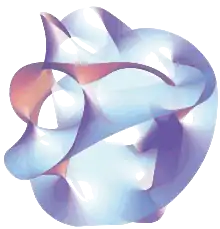F-theory
F-theory is a branch of string theory developed by Cumrun Vafa. [1] The new vacua described by F-theory were discovered by Vafa and allowed string theorists to construct new realistic vacua — in the form of F-theory compactified on elliptically fibered Calabi–Yau four-folds. The letter "F" supposedly stands for "Father".[2]
| String theory |
|---|
 |
| Fundamental objects |
| Perturbative theory |
| Non-perturbative results |
| Phenomenology |
| Mathematics |
Compactifications
F-theory is formally a 12-dimensional theory, but the only way to obtain an acceptable background is to compactify this theory on a two-torus. By doing so, one obtains type IIB superstring theory in 10 dimensions. The SL(2,Z) S-duality symmetry of the resulting type IIB string theory is manifest because it arises as the group of large diffeomorphisms of the two-dimensional torus.
More generally, one can compactify F-theory on an elliptically fibered manifold (elliptic fibration), i.e. a fiber bundle whose fiber is a two-dimensional torus (also called an elliptic curve). For example, a subclass of the K3 manifolds is elliptically fibered, and F-theory on a K3 manifold is dual to heterotic string theory on a two-torus. Also, the moduli spaces of those theories should be isomorphic.
The large number of semirealistic solutions to string theory referred to as the string theory landscape, with elements or so, is dominated by F-theory compactifications on Calabi–Yau four-folds.[3] There are about of those solutions consistent with the Standard Model of particle physics. [4]
Phenomenology
New models of Grand Unified Theory have recently been developed using F-theory.[5]
Extra time dimensions
F-theory, as it has metric signature (11,1), as needed for the Euclidean interpretation of the compactification spaces (e.g. the four-folds), is not a "two-time" theory of physics.
However, the signature of the two additional dimensions is somewhat ambiguous due to their infinitesimal character. For example, the supersymmetry of F-theory on a flat background corresponds to type IIB (i.e. (2,0)) supersymmetry with 32 real supercharges which may be interpreted as the dimensional reduction of the chiral real 12-dimensional supersymmetry if its spacetime signature is (10,2). In (11,1) dimensions, the minimum number of components would be 64. The superfield C being a cocycle of the ordinary 4-differential cohomology on Calabi-Yau varieties of moduli spaces of line bundles which under decomposition into various cup product associated with a divisor of the CY4, yields intermediate Jacobians and Artin-Mazur formal groups of degrees of maximum three (0,1,2).
References
- Vafa, Cumrun (1996). "Evidence for F-theory". Nuclear Physics B. 469 (3): 403–415. arXiv:hep-th/9602022. doi:10.1016/0550-3213(96)00172-1.
- Michio Kaku: The Universe Is a Symphony of Vibrating Strings - YouTube
- Taylor, Washington; Wang, Yi-Nan (2015). "The F-theory geometry with most flux vacua". Journal of High Energy Physics. 2015 (12): 164. arXiv:1511.03209. Bibcode:2015JHEP...12..164T. doi:10.1007/JHEP12(2015)164.
- [1903.00009] A Quadrillion Standard Models from F-theory
- Heckman, Jonathan J. (2010). "Particle Physics Implications of F-Theory". Annual Review of Nuclear and Particle Science. 60: 237–265. arXiv:1001.0577. doi:10.1146/annurev.nucl.012809.104532.
